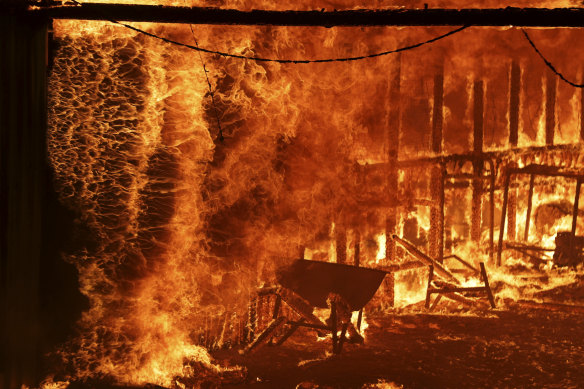This was published 5 years ago
'Extraordinary' fires burnt at historical size, beyond climate projections
By Peter Hannam
Australia's bushfires were not only "extraordinary" in scale but also exposed deficiencies in the climate models that are struggling to identify changes in rainfall and fire weather trends.
In a series of papers in Nature Climate Change published on Tuesday, scientists found the size of fires in NSW and Victoria were larger than any recorded since European settlement in Australia.

This season's bushfires were not only unprecedented in their size, they were also not well captured by climate models, scientists said.Credit: Alex Ellinghausen
They were also far bigger than similar forest fires elsewhere globally in at least the past two decades.
"In terms of the mid-latitude forests, this was a phenomenal event," said Ross Bradstock, head of the University of Wollongong's Centre of Environmental Risk Management of Bushfires, and an author of one of the papers.
Two fires - the Gospers Mountain and Currowan fires - each burnt more than half a million hectares, a "quite extraordinary" outcome for blazes caused by a single ignition point, Professor Bradstock said.
The paper estimated that 21 per cent of Australia's so-called temperate broadleaf and mixed forests had been burnt. That proportion was most likely an under-estimation because the tally only counted losses to the end of January and excluded those in Queensland, South Australia and Tasmania.
By contrast, average annual burnt areas for other continental forests were "well below 5 per cent" over the past 20 years. Taking Asian and African tropical and sub-tropical dry broadleaf forests alone, median annual losses were 8-9 per cent and the largest event about 13 per cent - well short of Australia's big event.
However, identifying the link between climate change and Australia's fires remains complicated, other papers showed.
Andrew King, a climate researcher at Melbourne University and lead author of one of the reports, said the dry conditions that preceded the fires were unusual and not well captured by climate models.
His team found the unusually long period since the last wet year was "the primary reason for the long-lasting dry conditions".
The 3½-year absence of rain-favouring La Nina events in the Pacific and the Indian Ocean equivalent - the negative phase of the Indian Ocean Dipole - was crucial for the dry set-up going into this season.
"Climate models have issues just simulating what's going on in the Indian Ocean and the Pacific Ocean to a slightly less degree," Dr King told the Herald. "How much can we trust them? We can't say much with any strong conviction."
While the science was clear that a warming world is ramping up temperatures almost everywhere - including in the region hard-hit by this season's blazes - it is less settled about how rainfall patterns have changed and what's to come.
"We don't currently have the capacity to make robust statements about what will happen in the future," Dr King said.
That knowledge gap could leave Australia under-prepared should drought become worse in the future, he said, adding, "It's holding us back in terms of adaptation."
A third paper, led by Benjamin Sanderson from France's CERFACS institute, argued climate models were failing to keep pace with improved fire models that were better at capturing "the evolution of fire risk".
"For NSW (the Australian state in which the fire extent is the most unprecedented), the scale of the fires is unmatched" in the latest generation of climate models, Dr Sanderson's paper said.
For instance, the sixth generation of so-called Coupled Model Intercomparison Project (CMIP6) only simulated similar fire extents at 4 degrees of warming, the paper found. (Warming since pre-industrial times is slightly more than 1 degree.)
"The fact that Australia has experienced damages that go beyond what is currently simulated highlights that current syntheses may be missing major risks," it said.